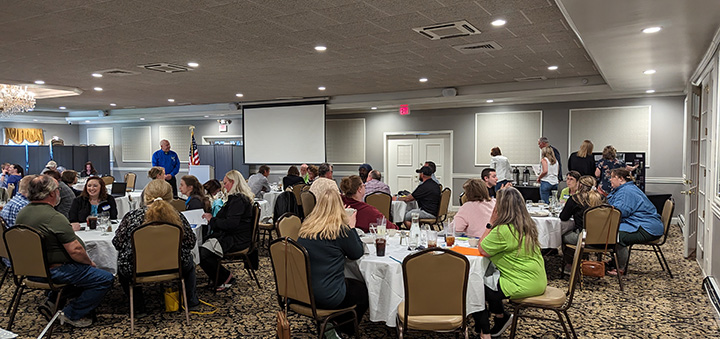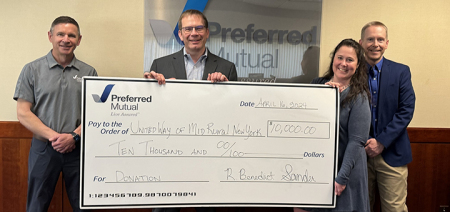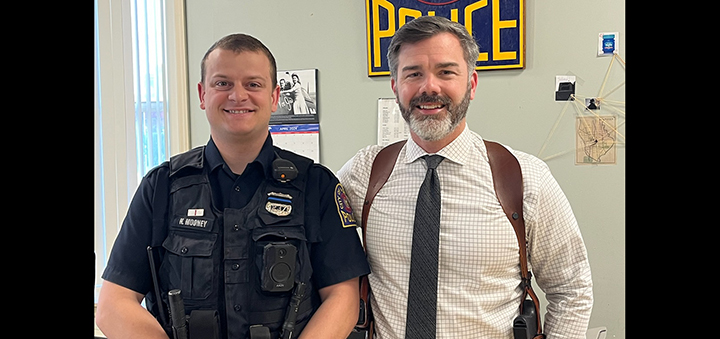The Impact Project Fights The Housing Crisis In Chenango County
Published:
May 12th, 2023
By:
Kelli Miller
 On May 9 at the Wild Owl Restaurant located on Route 12 in Greene, The Impact Project Executive Director James Willard III, staff and community members met to discuss the future of Chenango County homes and how to save them. (Submitted photo)
On May 9 at the Wild Owl Restaurant located on Route 12 in Greene, The Impact Project Executive Director James Willard III, staff and community members met to discuss the future of Chenango County homes and how to save them. (Submitted photo)
GREENE — On Tuesday, Impact Project Executive Director James Willard III and staff led a grassroots dinner meeting with approximately 70 community members to discuss the future of Chenango County homes and how to save them.
The meeting was at the Wild Owl Restaurant along Route 12 in Greene and those in attendance represented almost every facet of Chenango County including; education, construction, philanthropy, agencies, finance, contractors, media, and local government.
Willard said, “The Impact Project is a nonprofit dedicated towards helping people stay in their homes at no or little cost to the homeowner and there are still resources to help more than a dozen families throughout Chenango County this year.”
“What I'm about ready to lay out in front of you is a real problem in Chenango. The population of Chenango County is roughly about 45,000 people and one to four families are leaving the county weekly,” he said.
“Homeowners can’t repair their homes, furnaces aren’t working, windows need replacing, roofs are leaking and more. The home is no longer safe to live in. Typically, these are the older homes and instead of paying for costly building materials and labor for repairs of which most of these homeowners cannot afford, they decide to leave,” said Willard.
“On our website is a documentary that we partnered with Cornell University last year and at the end of the video, it talks about the topic, 'The Housing Crisis,'” Willard said, “The real housing crisis- and I'm not saying that because it’s the most important problem in the county, but it is the largest problem in Chenango County by far.”
“Pre-COVID, the working poor were working day to day, trying to provide for their family and falling short every month. People were struggling. They did not have enough money for food, gas, or to repair their homes. They were on SNAP, WICK, and meal programs at schools,” said Willard.
Willard explained that income, finances, age of homes and building costs are squeezing together to create this situation. Homes in Chenango County have the lowest median value in the Southern Tier. There are a lot of reasons for this, but every vacant home, left in poor repair or no repair, is effecting the value of local area homes.
Preston Town Supervisor Zachary Meseck said, “I’ve volunteered on previous Impact projects and the homeowners said they would recommend this opportunity to others. Although they said it was a little scary doing the paperwork, in the end, they got to keep their house.”
“I think it’s a worthwhile cause because The Impact Project is doing life changing things for people. It’s important that other agencies like the Department of Social Services along with the Chenango County Area Agency on Aging are offering support and collaboration to reach out to the homeowners to help them with their applications,” he added.
“If the right people hear the message, apply and get the help they need, or if someone is reading this and knows of someone in need of home repair, sharing the information can help so others know this project is out there. A lot of people have been helped just by hearing about it and applying.
“That’s one of the magical things about The Impact Project is you see at the end of the project just how grateful people are to keep their house,” Meseck said.
Mount Upton homeowner Lillian Chornoma DeCarlo said, “I'm 81 years old and moved here from Long Island years ago. I met friends up here and made a decision to be here. My family was sad to see me go but my one daughter was hurt on a job and when I moved up here, I found her dreadfully ill. We were going to Rochester for her doctors, hotel rooms and sometimes we were up there 16 days in a row.”
“Medical situations kept me putting out more and more to those bills and when I had to have something fixed in my home, I had to pay for it but it got to the point I didn't have any money. The roof was leaking and I couldn't afford it and so I thought about leaving. I didn't even know where I was going to go,” said DeCarlo.
“I heard about the Impact Project from my church and then I went to fill out the forms. I have to be honest, the form is so detailed and all of a sudden I'm pouring my whole soul out on this paper and I was terrified about making a mistake. I talked many times to a staff member about it and was so scared I'd make a thousand mistakes,” she said.
DeCarlo did finish the application and then received the call for the interview. After the interview and review, they scheduled the work to be done. The Calvary Baptist Church in Norwich, Sidney Federal Credit Union, and people DeCarlo had never met before came to her home and fixed the roof in one day.
“They did everything and I have a new roof and no more leaks,” DeCarlo said, “I’m very grateful for these people.”
“It’s real,” Willard said, “It’s real and here is where we are; 6,000 homes are gone and there are 9,000 more houses to fix. No agency can fix those 9,000 homes all at once. Some of these people are living in poverty, some living in the old homes and they can’t afford the building materials.”
“There is no other agency in this county that will do what we just did for Lillian DeCarlo, Willard said, “We evaluate homes, interview the homeowner, make the decision to move forward and get the repairs done. If additional repair is needed, we’ll get to that too,” Willard said.
Willard shared data he collected from Google, United for ALICE (United Way), Cornell University, US Census Bureau, US Facts.org., Chenango County government website, US Data.com, and the US Bureau of Labor Statistics:
13.9 percent of all homes in the United States are vacant and that during COVID, 61 percent of Chenango County residents were not making ends meet.
Chenango County had 1,600 vacant homes in 1970 and by 1990 those numbers rose to 3,000. Currently there are more than 5,000.
Labor stats reveal a staggering 25.2 percent of Chenango County homes were vacant as of March 31, 2023.
“We want to help this county,” Willard said, “Anybody can apply to The Impact Project, we will take an application from anyone regardless of their background,” said Willard. “We can’t help everybody, and there are services that we don’t do but people can find all of that information on our website.”
The Impact Project has two primary target populations: families at or below the Federal Poverty Guidelines- can qualify for no cost repairs and updates and families in Asset Limited, Income Constrained, Employed, (A.L.I.C.E.), who reside in Chenango County- can qualify for a loan program with terms up to $10,000 on a five year loan with a .5 percent interest rate.
This organization exists because of over 4,000 volunteers in the last 19 years have supported the cause.
For additional information or to apply for home repair, go to website: theimpactprojectgreene.org.
Author: Kelli Miller - More From This Author
Comments





